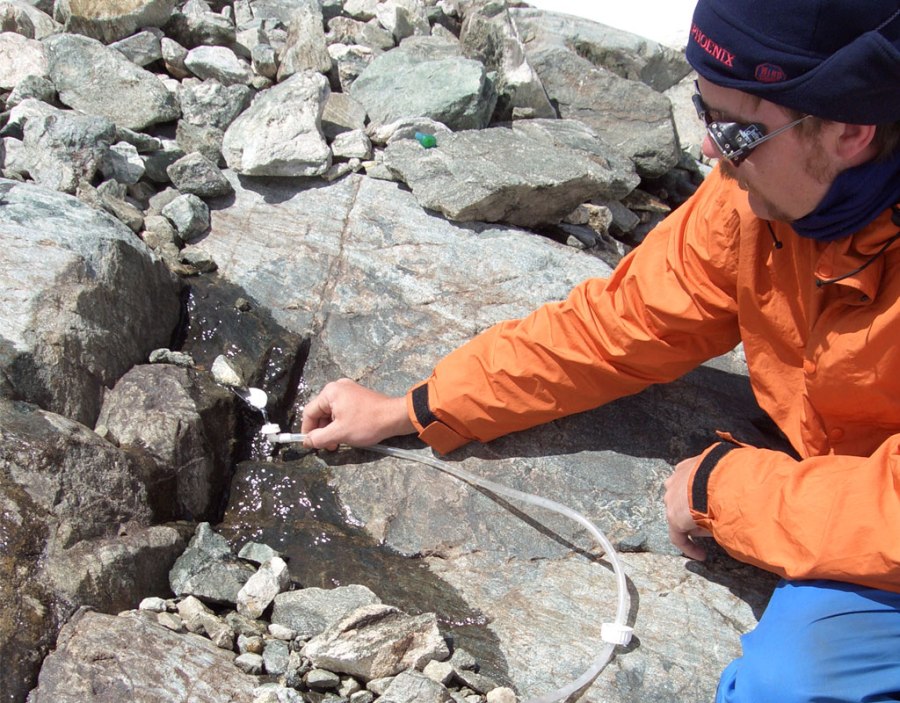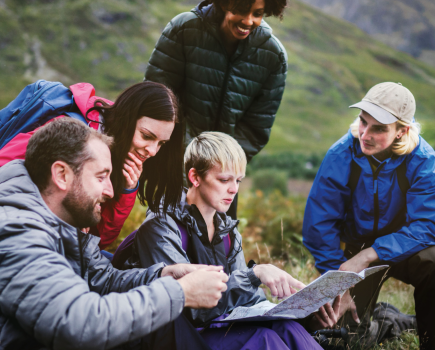Andrew Price of Dryad Bushcraft demonstrates how to get drinkable water from snow and ice
“Water Water everywhere, nor any drop to Drink”
Samuel Taylor Coleridge (The Ancient Mariner)
When Coleridge wrote this poem about a ships crew dying of thirst while surrounded by water he was of course referring to life at sea. However, the same predicament can befall those who venture into glacial or polar environments without the necessary equipment and knowledge to convert ice and snow into drinkable water. Water is essential to life, and the ability to transform water from its frozen state into its liquid state is a vital skill for those who intend to spend time above the snow line. In order to learn this skill it is important to first understand the unique properties of water.
Using a stove
Most mountaineers and explorers travelling in cold environments carry modern stoves that use liquid fuels such as unleaded petrol, propane gas or Coleman fuel in order to melt snow. One important thing to remember when melting snow is never to fill the pan to the top with snow to begin with. Snow is an excellent insulator and can cause the bottom of the pan to burn through rather than melting the snow. The best way to melt snow efficiently is to collect clean (definitely not yellow!) snow from outside the campsite. You should then put a small amount into the bottom of the pan and heat gently until it melts (snow is mostly composed of air so it will require a surprising amount of snow to produce a litre of water). Keep adding small handfuls until you have melted the desired quantity. It is a good idea to cover the top of the pan to conserve fuel. If you are in an area with trees or other fuel the same result can be obtained over a fire. Freshly melted snow is generally considered to be safe to drink without further treatment, however it should not be assumed that because water is frozen that it is safe to drink. Exercise the same caution for melted ice as you would for standing water, and if in doubt boil the water for 10 minutes. Micro organisms and germs are not killed by freezing (they just remain dormant until the ice melts).
Over a fire without a stove
If you do not have a heatproof pan you can still melt snow and ice by suspending it over a fire and allowing the melted water to drip into a container. Snow can be wrapped in a T-shirt or other porous item and supported using sticks or ski poles. If you are melting hard crust snow or sheet ice, you can suspend it over the fire without using a container. It can be cut or broken into a doughnut shape and turned on the stick to ensure it melts evenly.
Getting water without fuel
Obtaining water from ice and snow without a fuel source is not impossible. During the day the radiant energy of the sun will heat dark coloured rocks and melt the ice or snow in contact with them. Water can be found in this way even when the air temperature has not risen above -10C. The best way to locate this melt water is to listen for the tell tale sound of flowing water, particularly on south facing slopes or cliff faces. When the water is located it can be channelled into a container. This source of water is unlikely to continue long after dark so you should take every opportunity to hydrate yourself and collect water during the day time. Water bottles should also be kept in your sleeping bag with you to prevent freezing. (I often fill a water bag with hot water and take this into my sleeping bag with me – luxury!) Sucking snow and ice to obtain water is really an option of last resort. The effect of consuming ice cold snow will reduce your core body temperature, and increase the risk of developing hypothermia. Very cold ice can even cause burns to the lips and mouth. When venturing into a cold environment preparation and careful selection of equipment are vitally important. It is a good idea to seek the advice of a qualified Mountain Leader, or experienced explorer before undertaking such a venture. Even though the glacial environment is one of the hardest places to travel, the rewards in terms of spectacular scenery and unique personal challenges make it all worthwhile.
dryadbushcraft.co.uk







